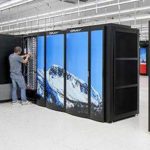“Blue Brain Project simulations use mathematical models of individual neurons and synapses to compute the electrical activity of the network as it evolves over time. This requires a huge computational effort, only possible with large supercomputers. Simulations of larger volumes of tissue, at ever higher levels of detail, will need ever more powerful computing capabilities.”
Creating Balance in HPC on the Piz Daint Supercomputer
The flagship supercomputer at the Swiss National Supercomputing Centre (CSCS), Piz Daint, named after a mountain in the Alps, currently delivers 7.8 petaflops of compute performance, or 7.8 quadrillion mathematical calculations per second. A recently announced upgrade will double its peak performance, thanks to a refresh using the latest Intel Xeon CPUs and 4,500 Nvidia Tesla P100 GPUs.
KAUST Empowers Researchers to Think Big
In this special guest feature, Jane Glasser writes that Saudi Arabia has moved into the global supercomputing top ten with Shaheen II, a 200,000-core behemoth that’s taming global warming, earthquakes, and more. “With 5.536 Pflops of sustained LINPACK performance, Shaheen II is the largest and most powerful supercomputer in the Middle East and the tenth fastest supercomputer in the world, according to the June 2016 TOP500 list.”






